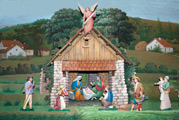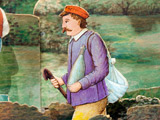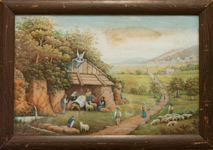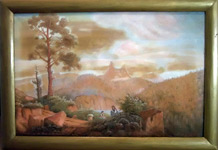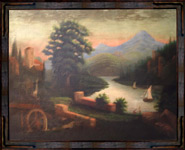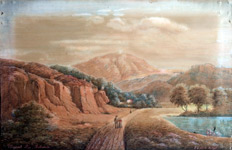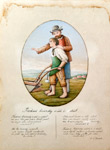ARTWORK
Ferdinand’s extant body of work contains three complete panoramic Nativity scenes, figures from unfinished scenes, and several paintings. The Nativity scenes vary in length between 10’ and 15’, and are over 2’ in height. They are 3-dimensional in effect, with multiple cut-outs of people, animals, and landscape scenes inserted into slots on a 12” baseboard.
There are three additional Nativity scenes by Ferdinand that were purchased by friends and relatives who lived in West, Texas. It is reported that they were sold for around $20. These scenes have yet to be located.
No two scenes are alike and few individual figures are identical. They are painted on salvaged cardboard from commercial products such as oatmeal boxes and packaging for shirts. One reason that they have been so well preserved is that the paint was mixed with Paris green or copper acetoarsenate, an extremely toxic substance, which at that time was used as a pigment, an insecticide, and a blue colorant for fireworks.
A typical feature in most of Ferdinand’s panoramas is the depiction of pastoral life on one side, with farmers and shepherds bringing their gifts of farm produce to the central manger, and city life on the other, with townspeople bringing presents of bakery products or manufactured goods.
Nativity art has a long tradition in the Czech lands and throughout Europe. In the middle ages it was used as a way to teach and demonstrate Christianity to the people. In periods when the Catholic Church was undergoing persecution and religious art was banned, the manufacture of such art became a cottage industry in many areas, and people personally commissioned scenes for display in private residences. This anchored the tradition in the local culture, as many people lent their talent to developing the art form.
Images of Ferdinand Pribyl's artwork follow, with photographs of three of his Nativity scenes. Below these are a number of landscapes painted by Ferdinand and gifted to family members. Click on any of the thumbnail images to open a larger version of the image in a separate window, and use your browser's Back button to navigate back to this page. These are large images and web browsers will try to fit the image to your screen size, so to see the full-size image, click on the image with the magnifier mouse cursor {![]() }. During the 2015 Christmas season, a talented video artist, Jeff Frownfelter, asked permission to use the three Nativity scenes to produce a video honoring the artwork and the theme of the birth of Christ. Jeff has a website of his work called Sensation Gallery. The beautiful video he produced may be viewed in its first and second renderings on YouTube.
}. During the 2015 Christmas season, a talented video artist, Jeff Frownfelter, asked permission to use the three Nativity scenes to produce a video honoring the artwork and the theme of the birth of Christ. Jeff has a website of his work called Sensation Gallery. The beautiful video he produced may be viewed in its first and second renderings on YouTube.
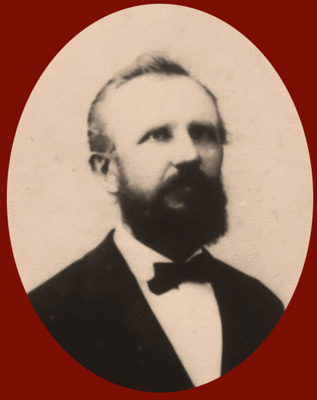 |
A 45-year old Ferdinand looks across the years at an older view of himself, some 15 or so years later, at an age when he began to create the Nativity scenes which are shown on this page. |
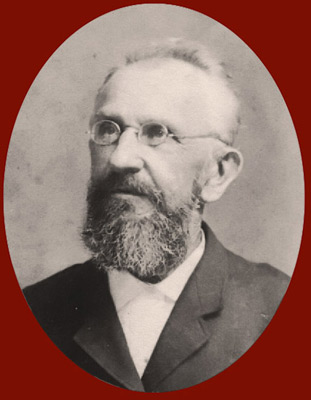 |
The Stockbauer Nativity
The images below are of the Stockbauer Nativity scene. This scene was given by Ferdinand Pribyl to his nephew, Albert Stockbauer, Sr., whom he and Anna raised alongside their own son, Anton. The scene was passed down to Albert's oldest son, Albert, Jr., who eventually gave it to his brother and sister-in-law, Fred and Elizabeth Stockbauer. It is the largest scene extant, measuring 15'-4" W by 2'-2" H. This scene was displayed in full at the University of Texas Institute of Texan Cultures (ITC) during the 2009 Christmas Holiday season. The ITC has a Facebook photo album of the exhibit setup here.
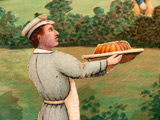 |
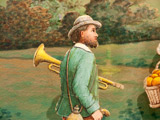 |
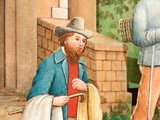 |
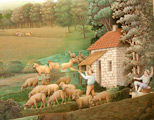 |
|
The Staha Nativity
The images below are of the Staha Nativity scene. When Ferdinand and Anna first came to Texas from Moravia, they lived with Jan for a while in Bluff, but then moved to Halletsville where Ferdinand taught at the newly opened Sacred Heart Catholic School. One of his students was Leopoldina Kallus, who married Robert Hanak. To honor the birth of their first daughter, Anastacia, Ferdinand gave the family this scene in December, 1900. It was passed down through descendents of the family to its present day owner, Mary Anne Staha, of Hallettsville. This scene lacked a baseboard and many of the figures were badly damaged. It was restored by Dr. Robert Shook, History Professor at University of Houston/Victoria campus, and Bette Stockbauer. The size of the scene is 10' W by 2' H. It was also on display with the Stockbauer scene at the ITC in 2009.
 |
 |
|||
 |
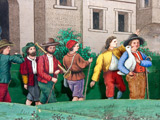 |
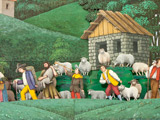 |
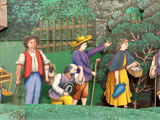 |
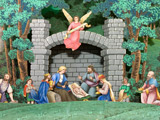 |
The Pribyl Nativity
The images below are of the Pribyl Nativity Scene, reputed to be the first created by Ferdinand, and given to his son, Anton. It measures 13'-2" W by 2'-8" H. This artwork is owned by the descendants of Ferdinand's grandchildren — Edwin T. Pribyl, Adolph V. Pribyl and Annie Pribyl Hauboldt. The Pribyl Nativity has been displayed in several venues.
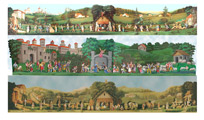 |
The thumbnail image at left is a link to a photo-montage of the three nativity scenes documented above, scaled to the same length to allow a direct comparison between them, as created by Dr. Robert Shook, retired Professor of History at Victoria College. Dr. Shook has put a great deal of effort into photo documentation of the scenes, as well as restoration work, such as making a new base and backdrop for the Staha scene. Many thanks to him for his tireless efforts in preserving this folkart tradition. |
The following links will open video players to show pans of the Stockbauer, Staha and Pribyl Nativity Scenes:
(Note: You may need to override your browser's security settings to allow the video script to play)
• Stockbauer Nativity Pan Video
• Staha Nativity Pan Video
• Pribyl Nativity Pan Video
Following are photos of some paintings by Ferdinand Pribyl.


